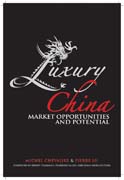
The Chinese luxury market currently generates more than US$2 billion in salesper year. It is expected to grow 10 percent annually until 2015, when sales are expected to exceed US$11.5 billion. By 2010, China is expected to have 250 million consumers who can afford luxury products. As China's economy surges ahead, the growing urban-affluent segment is luring luxury goods providers worldwide. Disposable income (a remarkable increase of nearly 600% in the past fiveyears) has fuelled this increasing appetite for riches. Status is now de rigeur and the world's top brands are cashing in big time. Cartier will soon have 30 stores in China, second only to the number in the United States. Bulgari plans to increase its outlets in the greater China region to 17. Prada, with 22 outlets, is building a flagship store in Shanghai. Valentino, the fashion house owned by Marzotto, hasn't set up any flagship stores in Australia, but has two in Mainland China. Giorgio Armani will have 54 stores in China. More than 300,000 Chinese already have a net worth of more than US$1 million and the mainland's millionaires control about US$530 billion in assets. The China Brand Association estimates that about 13 percent of China's population, or 170 million people, now buy top-tier brands. This trend will only continue as luxury brands shift their focus to capitalize on the growing affluent market in China. The population of luxury goods consumer is expected to increase to 250 million by 2010, gaining the same purchase power as Japan as per China Brand Association. While the numbers are staggering, Luxury China hones in on the opportunities for luxury brands in China, as well as guidelines on how to succeed and tapthis tremendous market potential.
- ISBN: 978-0-470-82341-5
- Editorial: John Wiley & Sons
- Encuadernacion: Cartoné
- Páginas: 300
- Fecha Publicación: 28/09/2009
- Nº Volúmenes: 1
- Idioma: Inglés
